Introduction
Florida’s scrub ecosystems are characterized by deep, well-drained, nutrient-poor, sandy soils and areas of open, bare sand dominated by xeromorphic plants (i.e., plants that have adapted specialized traits to help withstand very dry conditions; Figures 1 and 2). Plants in these ecosystems must endure harsh conditions because water and nutrients drain quickly through sandy soil, and the sparse canopy provides little relief from the hot Florida sun. Various survival strategies enable xeromorphic plants to thrive and compete in dry conditions. The curled, waxy-surfaced leaves of Quercus geminata, for instance, allow the tree to reduce water loss; and Ceratiola ericoides’ extensive root systems ensure that it absorbs as much water as possible from the soil. (Florida Land Steward Program, n.d.)
An environmental constant that shaped the evolution of scrub ecosystems alongside water was fire. Fire continues to play an important role in maintaining the health and biodiversity of these habitats. The intervals between fire events in these habitats typically range from 5 to 30 years depending on the site conditions (e.g., soil type, water drainage) and scrub community (e.g., rosemary scrub, sand pine scrub). Fires generally top-kill woody shrubs (e.g., Lyonia spp.) and scrub oaks, which can re-sprout from underground root systems while other scrub plants (e.g., Pinus clausa, Ceratiola ericoides) will be completely killed and regenerate from seed. Fire also reduces litter on the forest floor, increasing areas of open bare sand where many rare scrub plants occur (Schmaltzer, 1998). In the absence of fire, plant diversity will decrease over time because scrub communities tend to convert to a xeric hammock ecosystem (FNAI, 2010).
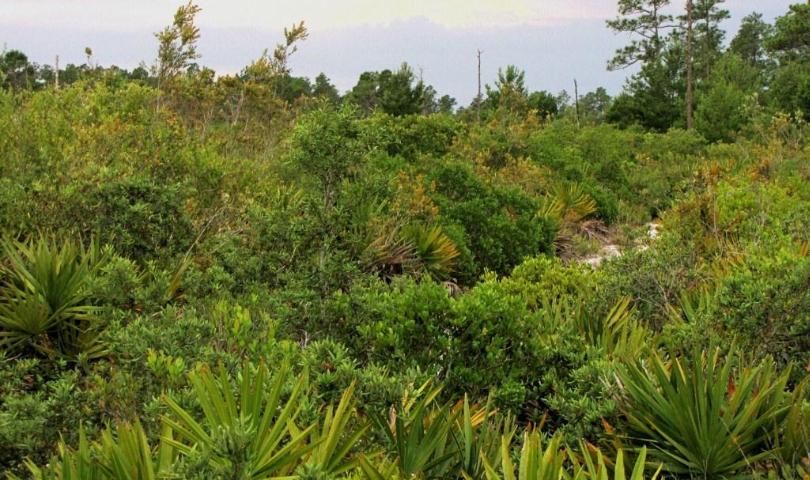
Credit: Lynn Proenza, UF/IFAS
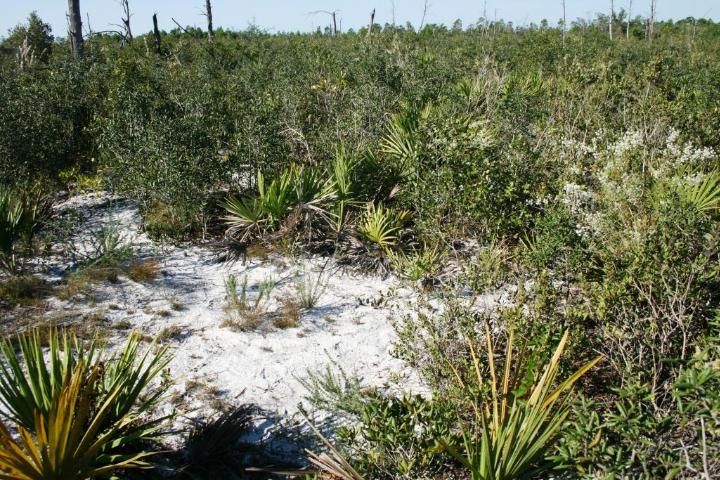
Credit: Michael Andreu, UF/IFAS
The purpose of this fact sheet is to help identify a few of the more common woody plant species found in Florida’s scrub ecosystems. In the individual plant descriptions, words that appear in bold font are considered to be key field characteristics that will aid in identification of the species. These field characteristics are not meant to be comprehensive to all plants in scrub but rather only highlight those that they are most commonly mistaken for. The species covered in this document follow Wunderlin and Hansen (2008) and are grouped by vegetation type according to the following outline:
Pine
- Pinus clausa; sand pine, scrub pine
Oaks
- Quercus chapmanii; Chapman’s oak
- Q. geminata; sand live oak
- Q. inopina; scrub oak, sandhill oak, Florida scrub oak
- Q. myrtifolia; myrtle oak
Palms
- Sabal etonia; scrub palmetto
- Serenoa repens; saw-palmetto
Woody Shrubs
- Bejaria racemosa; tarflower, fly-catcher
- Carya floridana; scrub hickory
- Ceratiola ericoides; Florida rosemary, rosemary, sand heath
- Hypericum tenuifolium; Atlantic St. John’s wort
- Ilex opaca var. arenicola; scrub holly, American holly, hummock holly
- Lyonia ferruginea; rusty lyonia, stagger-bush (with a note on L. fruticosa)
- Lyonia lucida; fetterbush, stagger-bush, shiny lyonia
- Palafoxia feayi; palafoxia, Feay’s palafox
- Persea borbonia var. humilis; silk bay
- Vaccinium myrsinites; shiny blueberry (with a note on V. darowii)
Scrub Vegetation
Pine
Pinus Clausa; Sand Pine, Scrub Pine
Form
Evergreen tree up to 25 m tall but usually 8–14 m (Figure 3). Diameter at breast height (DBH) up to 51 cm. Branches are dense, commonly droop, and are often not self-pruned (lower branches persistent). Cones are persistent.
Stem
Grayish and scaly or smooth (towards top of trunk or new growth) turning plate-like and reddish brown (lower portion of trunk) with age.
Leaves
Simple, alternate, spiral. Needle-like, 5–10 cm long with 2 needles per fascicle. Needles are green to yellowish-green and may be straight or slightly twisted (Figure 4).
Reproduction
Pollen cones appear in early spring. Monoecious, inconspicuous. Males: yellow, long, and slender. Females: purple to yellow. Seed cones usually clustered, 2–10 cm long, brown; spines are short and stout; serotinous (Pinus clausa var. clausa) or non-serotinous (Pinus clausa var. immuginata) depending on variety; typically persistent on branches (Figure 5).
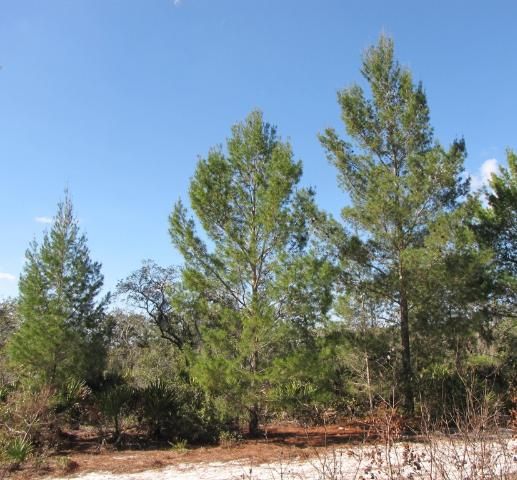
Credit: Lynn Proenza, UF/IFAS
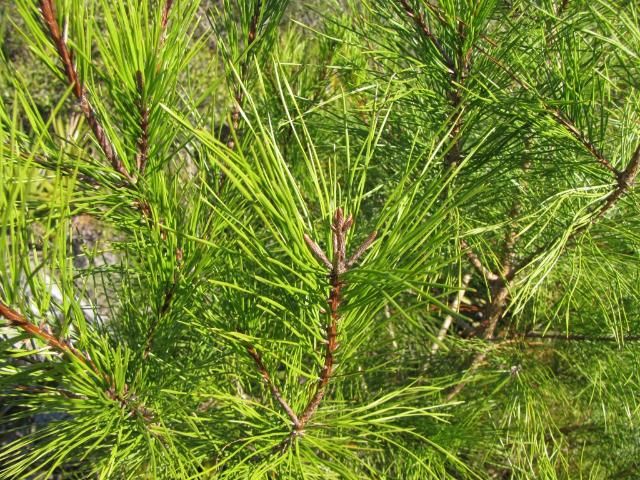
Credit: Lynn Proenza, UF/IFAS
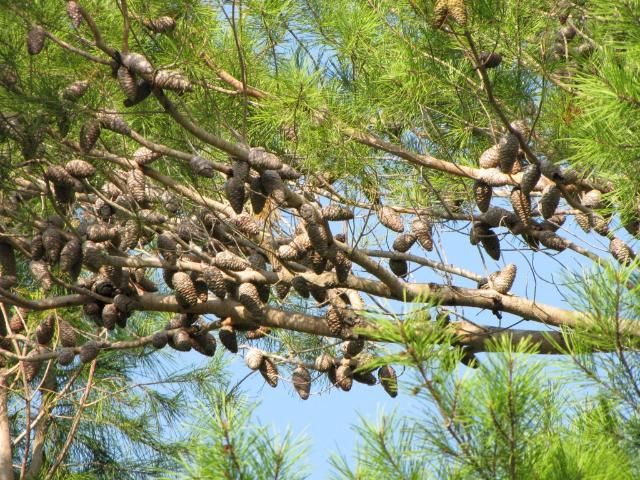
Credit: Lynn Proenza, UF/IFAS
Oaks
Quercus chapmanii; Chapman’s Oak
Form
Semi-evergreen shrub to small tree to 14 m tall but commonly to 3 m tall. Forms thickets by spreading via subterranean runners.
Stem
Scaly, brown to grayish-brown. New twigs tan to yellowish, densely pubescent becoming gray with age. Buds reddish-brown.
Leaves
Simple, alternate. Size and shape of leaves vary, obovate to oblanceolate, leaf broadest at apex from 4–10 cm long and 1–8 cm wide. Upper surface shiny to dull dark green, occasionally with some pubescence. Lower surface dull green, yellowish to grayish with tan to yellow pubescence usually along midrib shedding with age (Figure 6). Some leaves becoming yellow to red in the fall and winter, shedding by spring. Margins vary from shallowly lobed, sparsely lobed (3–5 lobes), wavy, or entire. Lobes usually rounded. Apex rounded. Base attenuate, cuneate, or rounded.
Flowers
Late winter to early spring.
Fruit
Acorn up to 1.5 cm long. Annually produces either 1 or 2 on a peduncle. Cup encompasses approximately half of the nut, scales gray, pubescent. Nut brown to light brown oval. Apex round, occasionally with pubescence.
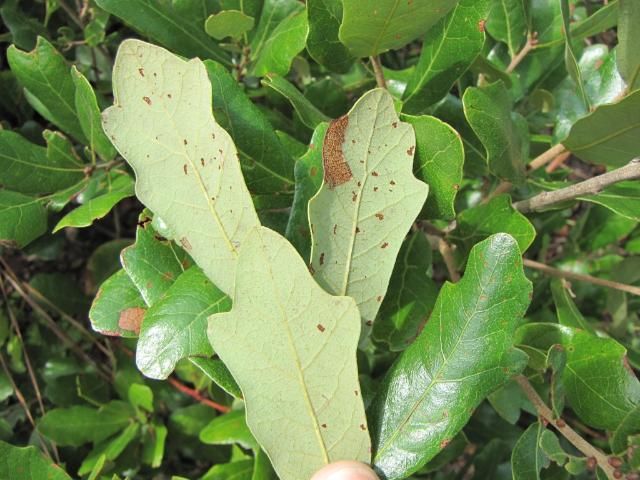
Credit: Lynn Proenza, UF/IFAS
Quercus geminata; Sand Live Oak
Form
Tardily deciduous small shrub to large tree up to 29 m tall but commonly only reaches 15 m tall. Forms thickets by spreading via subterranean runners.
Stem
Scaly, dark brown to black. Smooth when young, becoming deeply furrowed with age and size. Twigs dark brown, yellowish, to light gray.
Leaves
Simple, alternate. Leathery and stiff. Elliptic to narrowly lanceolate 2–12 cm long, 0.5–4 cm wide. Upper surface dark to light green, shiny, glabrous. Lateral veins and midrib commonly impressed. Lower surface grayish to tan with dense stellate pubescence. Margins strongly revolute, so that the leaf resembles a boat (Figure 7). Petiole densely pubescent, 2–10 mm long.
Flowers
Spring. Produced annually, usually in clusters of 2 to 6.
Fruit
Acorns up to 2 cm long, produced annually usually in clusters of 2 to 6. Cups with pubescent to smooth gray scales that cover approximately one-third of the nut; nut dark brown to black.
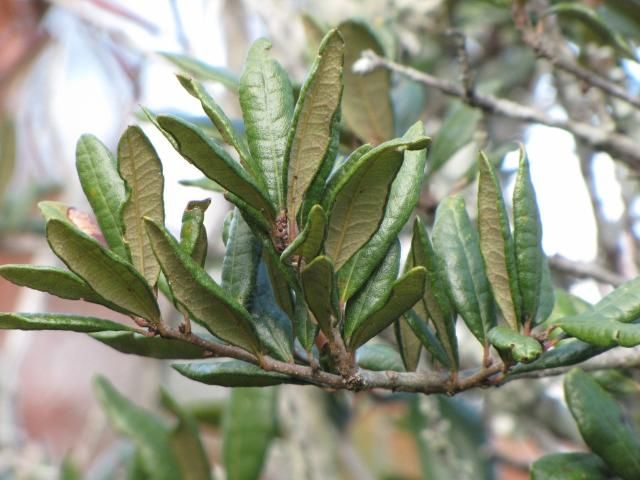
Credit: Lynn Proenza, UF/IFAS
Quercus inopina; Scrub Oak, Sandhill Oak, Florida Scrub Oak
Form
Evergreen shrub to 5 m, but usually 1–1.5 m tall. Forms thickets by spreading via subterranean runners. Leaves commonly held “vertically” on plant due to twisted petioles.
Stem
Light gray to brown.
Leaves
Simple, alternate. Usually elliptical, 2–12.5 cm long, 1.3–7.5 cm wide. Upper leaf surface is smooth or has impressed veins and is usually covered in ascocarps (a fungus that appears as small black dots). Lower surface is glabrous to sparsely pubescent, mostly at the base and along the midrib. The pubescence is yellow and scurfy. Margins heavily revolute; apex rounded to obtuse; base rounded, obtuse, or acute. Leaves held “vertically” on plant due to twisted petioles (Figure 8).
Flowers
Spring. Occurs after Q. myrtifolia has flowered.
Fruit
Acorn, matures in 2 years. Oval to elliptical, up to 2 cm long and 1.5 cm wide. Cup covers up to half of the nut. Scales on outer cup are pubescent.
Distinguishing characteristics
When comparing this species to Q. myrtifolia, the leaf of Q. inopina is twice as long as it is wide and is usually elliptical, whereas Q.myrtifolia is less than twice as long as it is wide and is usually obovate.
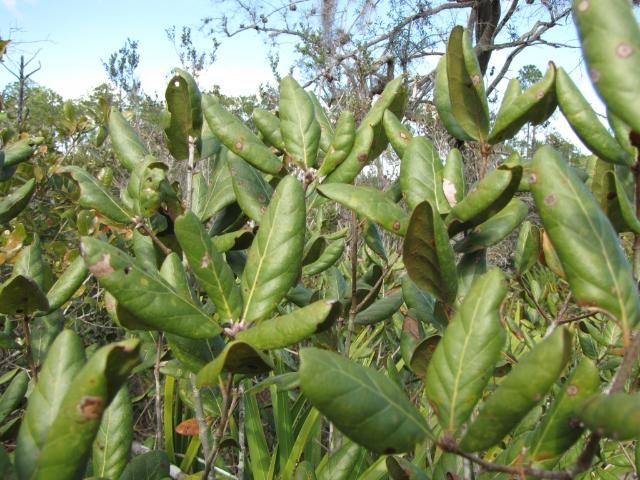
Credit: Lynn Proenza, UF/IFAS
Quercus myrtifolia; Myrtle Oak
Form
Tardily deciduous shrub to 11 m. Typically forms thickets. Branches are usually crooked. Forms thickets by spreading via subterranean runners.
Stem
Smooth and gray turning dark gray and furrowed with age. Twigs reddish-brown and pubescent. Terminal buds are ovoid, up to 5.5 mm long, purplish to reddish-brown to brown, and occasionally with tan pubescent tufts. New growth with dense stellate pubescence.
Leaves
Simple, alternate. Leathery and stiff. Elliptic, oval, or, more commonly, obovate. Size variable, 2–8 cm long and 1–5 cm wide. Upper surface shiny, dark green, sparsely pubescent usually becoming glabrous with age. Lower surface dull to somewhat shiny, green to yellow-green, mostly glabrous with some pubescence occurring within axils of midrib and lateral veins (Figure 9). Margins slightly revolute, sometimes wavy. Bristle tips rare. Apex commonly rounded but sometimes obtuse. Base rounded to cuneate.
Flowers
Spring. Occurs before Q. inopina.
Fruit
Acorn, matures in 2 years. Grayish-brown, round, ovoid to globose, up to 1.6 cm long and 1.2 cm wide. Cup covers approximately one-fourth to one-third of nut. Tan, sparsely pubescent on outer surface, densely pubescent on inner surface.
Distinguishing characteristics
When comparing this species to Q. inopina, the leaf of Q. myrtifolia is less than twice as long as it is wide and is usually obovate, whereas the leaf of Q. inopina is twice as long as it is wide and is usually elliptical.
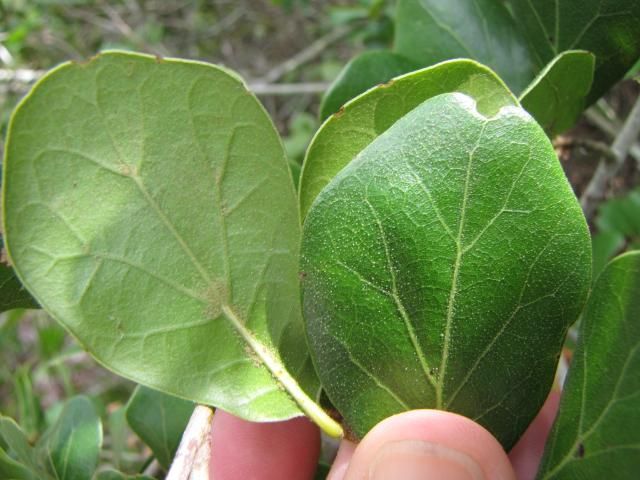
Credit: Lynn Proenza, UF/IFAS
Palms
Sabal Etonia; Scrub Palmetto
Form
Perennial. Height commonly 1 m. Contorted or “S”-shaped subterranean stems. Bud is generally below ground (Figure 10).
Leaves
Costapalmate, approximately 1 m long (Figure 11). Usually 3–5 leaves present at a time. Petioles 25–40 cm long, up to 2 cm wide, margins smooth (without prickles) and arch upwards. The triangular hastula extends past the base of the leaf giving the leaf a “folded” appearance. The hastula is 1.2–4 cm long and triangular. Fibers occur between leaf blade segments, green to yellowish-green.
Flowers
Spring to summer. White, 5–6 mm flowers occur in an inflorescence that can reach the length of the leaf.
Fruit
Black to brownish-black ovoid drupe to 15 mm long when mature.
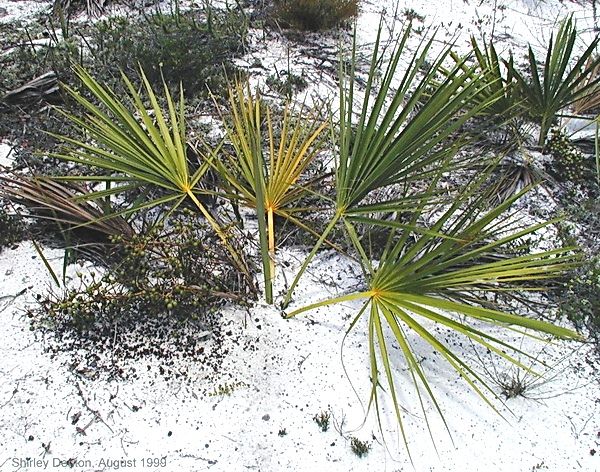
Credit: © 2000 by Shirley Denton

Credit: © 2000 by Shirley Denton
Serenoa Repens; Saw-Palmetto
Form
Perennial, capable of reaching 7 m in height, but commonly grows horizontally along the ground or just below the ground. Stems can lean, creep, or grow erect (Figure 12 to Figure 14). Can form large thickets.
Stems
Stems covered by old leaf bases or leaf scars and thick brown fibers.
Leaves
Palmate (fan-like) with no midrib, up to 1 m wide. Petioles 5–10 decimeters (dm) long and up to 1.5 cm wide. Light to dark green, occasionally blue-green. Margins of petioles have recurved saw-like prickles. Hastula approximately 10 mm, rounded to deltoid (Figure 15).
Flowers
Up to 5–6 mm long borne on an inflorescence that is shorter than the leaf length.
Fruit
Black drupe, ellipsoid to 25 mm long, 15 mm wide.
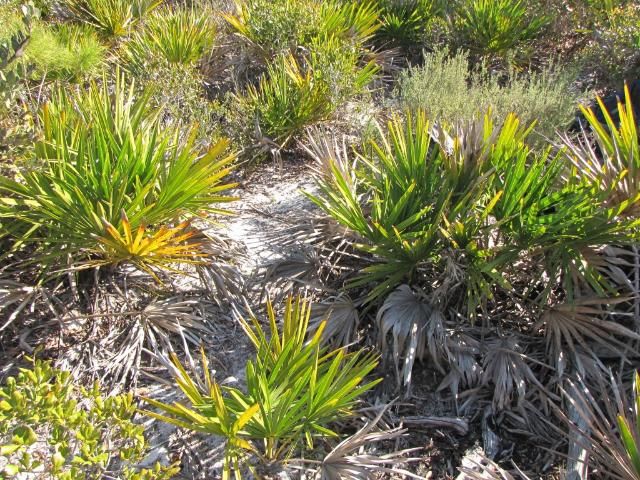
Credit: Lynn Proenza, UF/IFAS
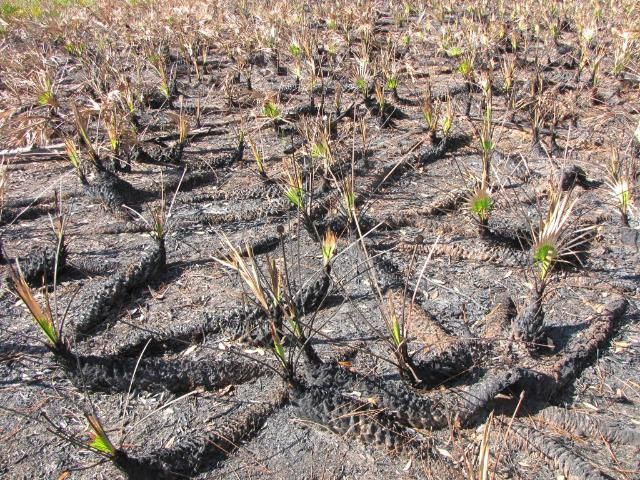
Credit: Lynn Proenza, UF/IFAS
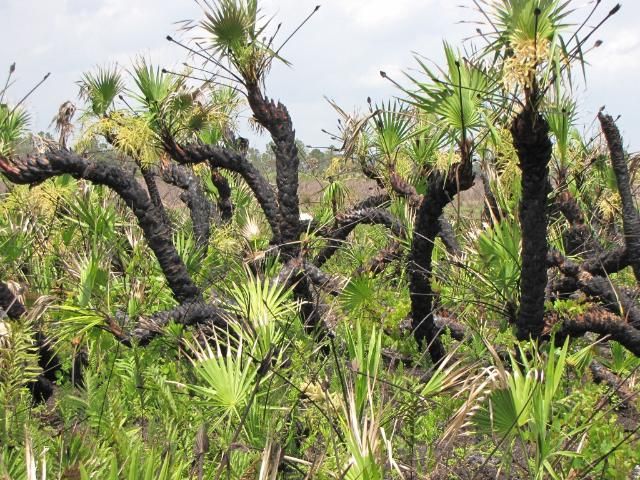
Credit: Lynn Proenza, UF/IFAS
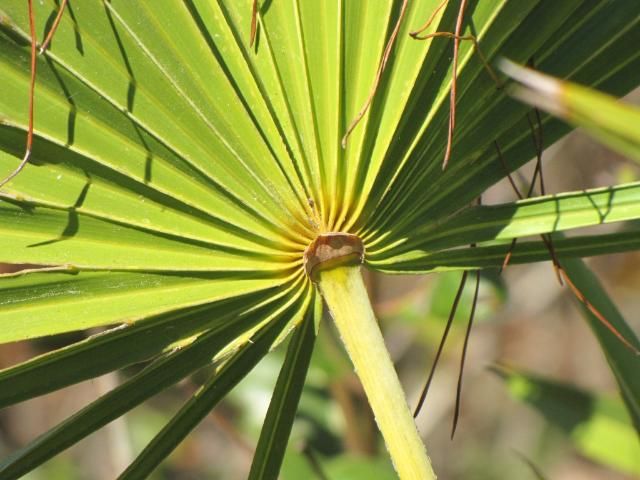
Credit: Lynn Proenza, UF/IFAS
Woody Shrubs
Bejaria Racemosa; Tarflower, Fly-Catcher
Form
Evergreen shrub with few erect branches, to 2.5 m tall.
Stem
Stems powdery-pubescent with long hairs (Figure 16).
Leaves
Simple, alternate, sessile. Elliptic to ovate 2–6 cm long, to 2 cm wide. Upper surface has powdery pubescence. Lower surface lighter (whitish) in color with some long hairs at the midrib. Margin entire, apex rounded to acute, base cuneate.
Flowers
White to pinkish with seven separated petals to 2–3 cm long (Figure 17). Sticky, aromatic.
Fruit
Capsule 6–8 mm in diameter, sticky. The pistil persists on the mature fruit.
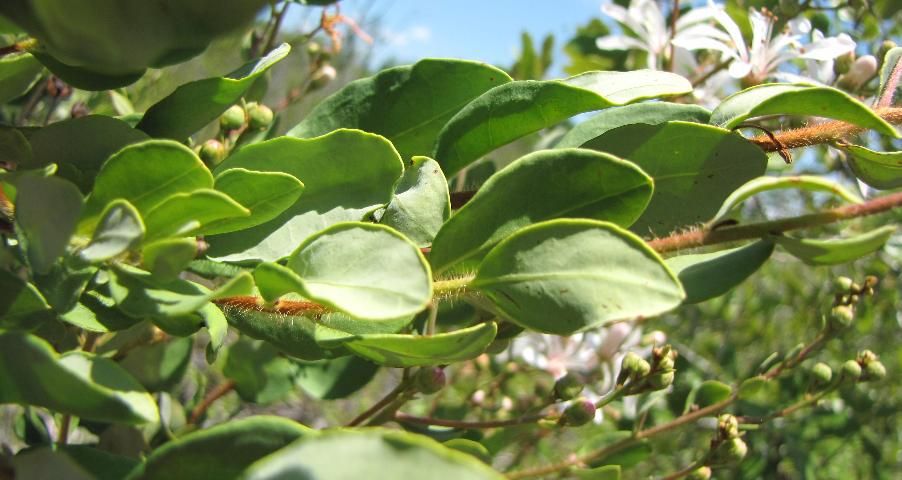
Credit: Lynn Proenza, UF/IFAS

Credit: Lynn Proenza, UF/IFAS
Carya floridana; Scrub Hickory, Florida Hickory
Form
Deciduous, commonly a shrub to 5 m tall, but can reach up to 25 m tall. Multi-trunked.
Stem
Smooth when young then with interlacing fissures as it ages. Light gray to brown-gray. Twigs rusty to brown with gray flecks, sometimes with pubescence.
Leaves
Alternate, odd-pinnately compound (Figure 18). Petioles pubescent and scaly in spring. 3–7 leaflets, most commonly 5 or 7, elliptic, ovate, obovate to lanceolate. The terminal leaflet is typically the largest up to 8–20 cm. Upper surface rusty, turning green and glabrous with age. Lower surface rusty-scaly with pubescence in axils of midrib and lateral veins. Margins serrate. Apex acuminate to acute. Terminal leaflet cuneate. Lateral leaflet bases rounded to obtuse and sometimes inequilateral. Leaf scars crescent-shaped to circular.
Flowers
Spring. Catkins 2–2.5 mm with rusty pubescence on some parts (Figure 18).
Fruit
Dark brown to rusty-scaly nut, obovoid to oblong, 2.5–4 cm long (Figure 19). Husks rough, hard, and thin, approximately 2–3 mm thick.
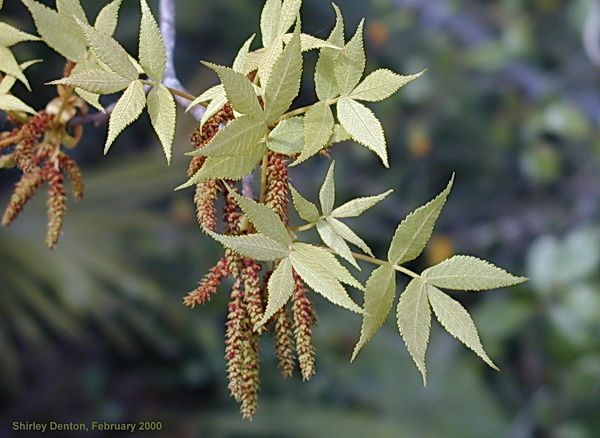
Credit: © 2000 by Shirley Denton

Credit: © 2000 by Shirley Denton
Ceratiola ericoides; Florida Rosemary, Rosemary, Sand Heath
Form
Evergreen shrub, erect, bushy-branched, mound-like or round, to 3 m tall (Figure 20).
Stem
Dense gray pubescence along young twigs. Leaf scars are raised, producing a roughened look and feel. Gray bark showing inner brown color, which also turns gray with age.
Leaves
Simple, appear whorled but are opposite. Needle-like, commonly 8–12 mm long, 1 mm wide (Figure 21). Aromatic.
Flowers
Fall. Yellow to red, 1.5 mm long, borne in axils of leaves.
Fruit
Drupe, greenish-yellow, 2–3 mm in diameter, 2 seeds per fruit, juicy.
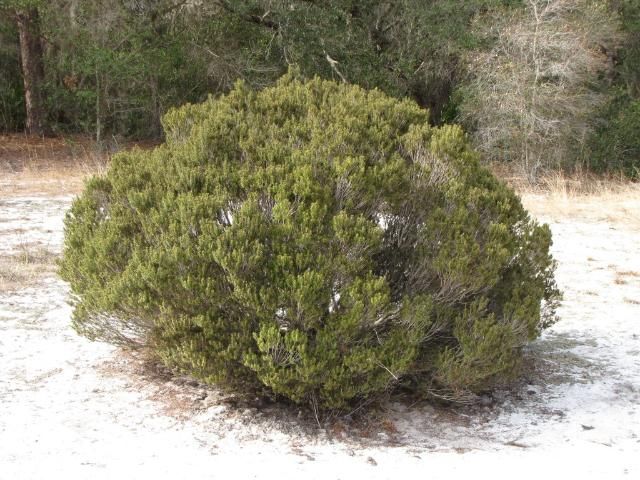
Credit: Lynn Proenza, UF/IFAS
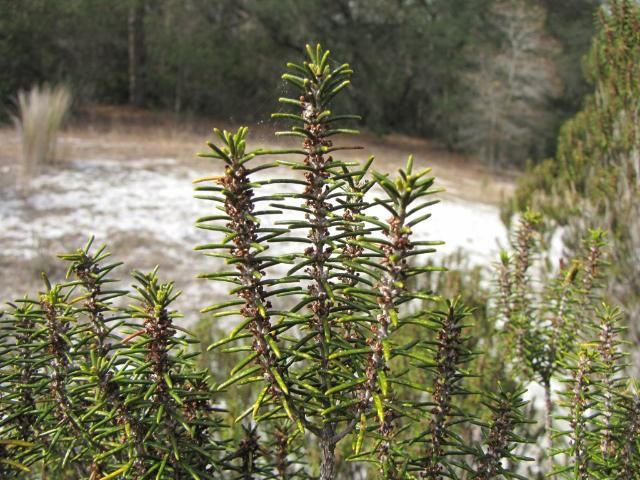
Credit: Lynn Proenza, UF/IFAS
Hypericum tenuifolium; Atlantic St. John’s wort
Form
Small, evergreen shrub, commonly 10–20 cm tall but can reach 50 cm.
Stem
Tight, thin bark flakes off in strips or plates.
Leaves
Needle-like to 5–10 mm long, strongly revolute with margins commonly touching the lower surface. Margins are punctate and the upper surface of the leaf is sparsely punctate. Aromatic.
Flowers
Yellow, up to 8 mm long, 5 petals, borne singly in axil of leaf (Figure 22).
Fruit
Capsule, up to 10 mm long, commonly between 4–5 mm, conical.
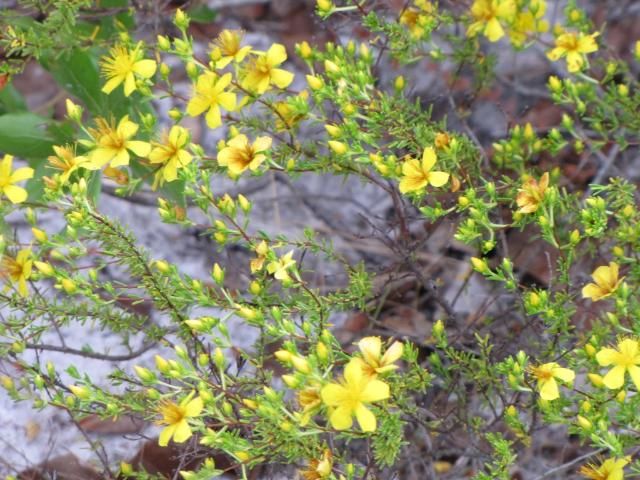
Credit: Lynn Proenza, UF/IFAS
Ilex opaca var. arenicola; scrub holly, American holly, hummock holly
Form
Evergreen shrub or tree up to 5 m tall. Branches and twigs ascending and crooked. Dioecious, fruit appears on female plants only.
Stem
Smooth, light gray.
Leaves
Simple, alternate, thick, leathery, up to 5 cm long, 2.5 cm wide. Yellowish-green upper surface and olive green lower surface. Margins revolute with sharp, spiny dentations (teeth; Figure 23).
Flowers
Cream to white, 4-lobed (Figure 23).
Fruit
Drupe, appearing on female plants only (dioecious). Yellow to orange-red with age, showy, up to 10 mm in diameter (Figure 24).
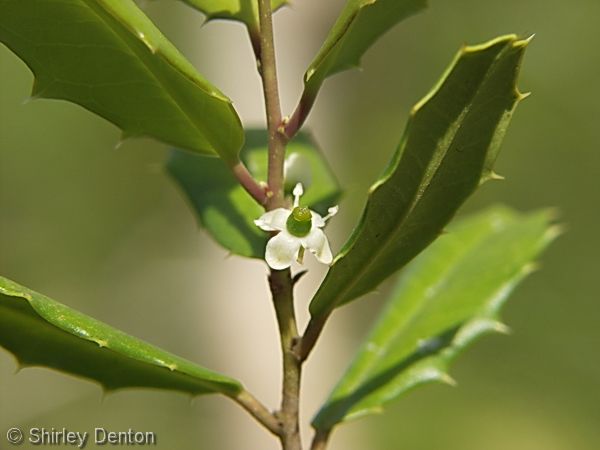
Credit: © 2005 by Shirley Denton
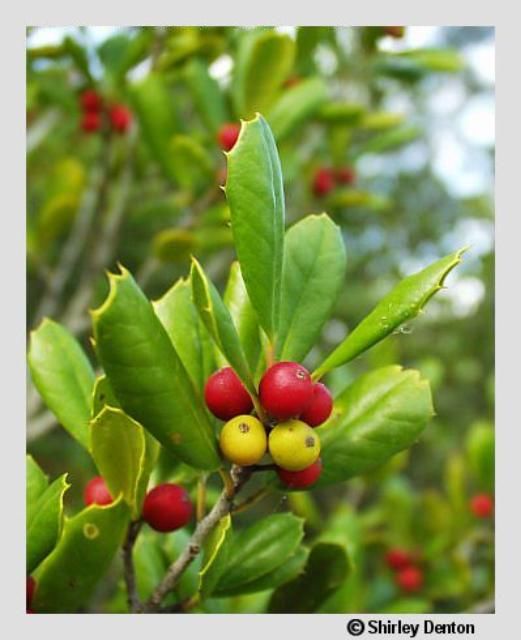
Credit: © 2005 by Shirley Denton
Lyonia ferruginea; rusty lyonia, rusty stagger-bush
Form
Evergreen, commonly up to 6 m tall but can reach up to 12 m. Stems and trunks crooked. Rhizomatous.
Stem
Stems and branches crooked. Grayish to brown twigs with rusty to gray pubescence and scales, sloughing with age.
Leaves
Simple, alternate, elliptic, obovate, to ovate, 1–9 cm long, 0.5–4 cm wide. When young, leaf surfaces are covered in rusty pubescence sloughing with age (Figure 25). Upper surface dark green with some pubescence along midrib commonly with impressed lateral veins. Lower surface pubescent with gray- and rusty-colored scales of two different sizes. Margins of young leaves entire, becoming revolute with age. Apex acute to obtuse, base cuneate.
Flowers
Spring. White clusters borne in axils of branches and twigs of previous season. Urceolate (Figure 26).
Fruit
Capsule. Ellipsoid to ovoid. Pubescent. Five-angled.
Distinguishing characteristics
Lyonia fruticosa is very similar to L. ferruginea and both species are often found growing together. L. fruticosa, however, has scales on the lower leaf surface in just one size, whereas L. ferruginea has scales in two sizes. The surfaces of the leaves on L. fruticosa turn dull gray with age, leaf edges curve slightly upwards (Figure 27), and veins are not impressed on the upper surface.
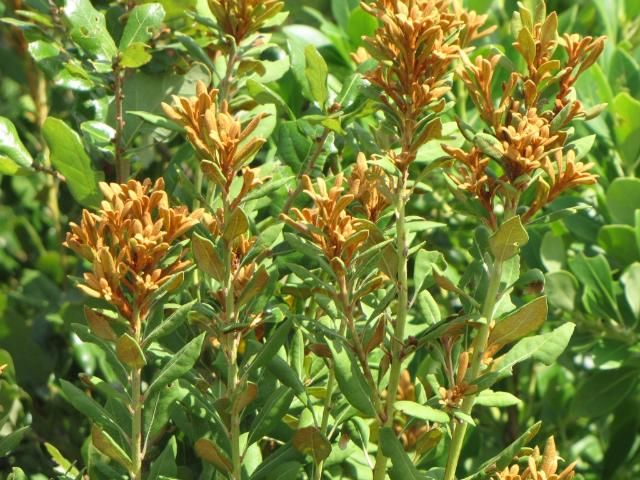
Credit: Lynn Proenza, UF/IFAS
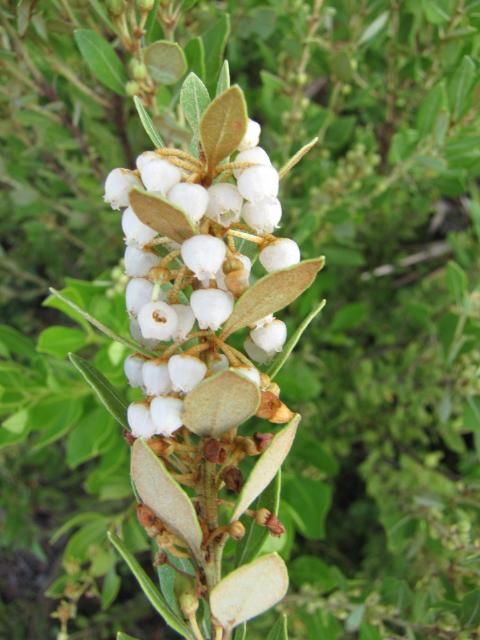
Credit: Lynn Proenza, UF/IFAS
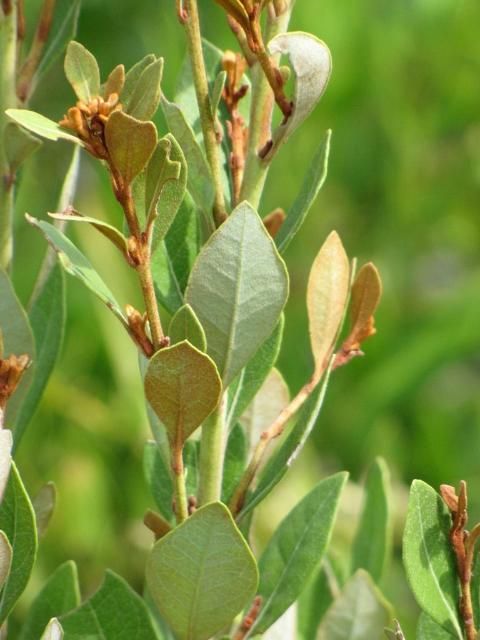
Credit: Lynn Proenza, UF/IFAS
Lyonia lucida; fetterbush, stagger-bush, shiny lyonia
Form
Evergreen shrub up to 4 m tall although commonly less than 1 m (Figure 28). Multi-trunked or branched.
Stem
Stems, branches, and twigs are erect or arching, typically 3-angled or keeled, green to reddish-brown with age.
Leaves
Simple, alternate, leathery. Commonly broadly elliptic, otherwise oval to obovate. 2–8 cm long, 1–4 cm wide. Upper surface glossy, glabrous, dark green, sparsely punctate dotted. Lower surface paler with a greater number of purple to brown punctate dots. Margins entire to slightly revolute with a yellow to yellow-green vein running closely alongside the margins (Figure 29). Apex acute to minutely acuminate. Base cuneate.
Flowers
Reddish to pink or white, cylindric, up to 1 cm long (Figure 30).
Fruit
Capsule. Round to urceolate, up to 5 mm long.
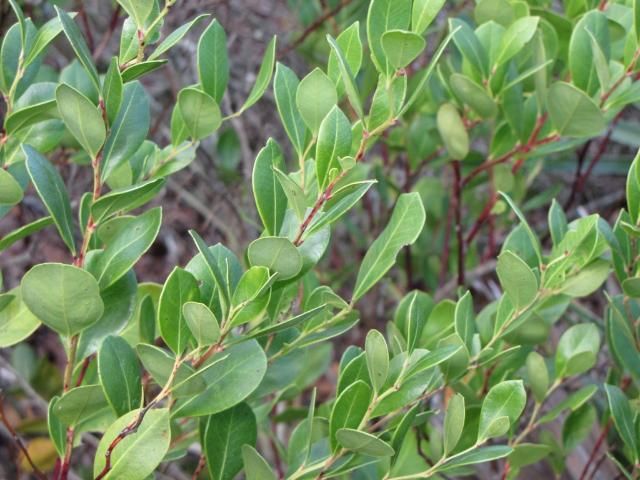
Credit: Lynn Proenza, UF/IFAS
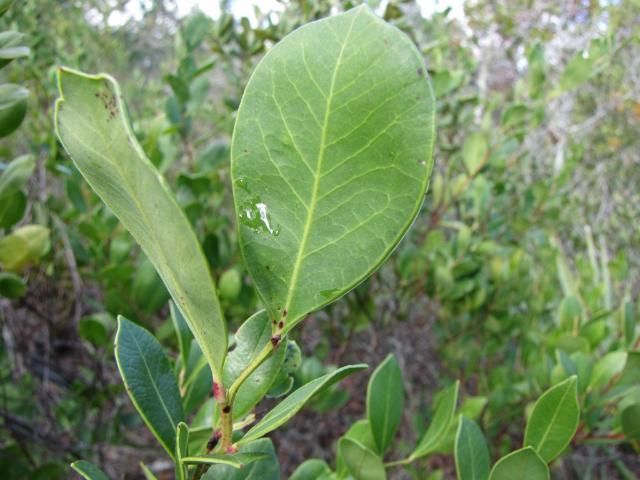
Credit: Lynn Proenza, UF/IFAS
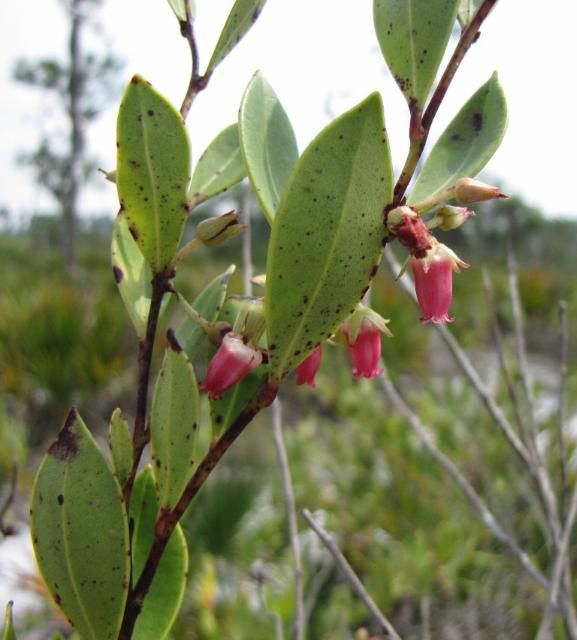
Credit: Lynn Proenza, UF/IFAS
Palafoxia feayi; palafoxia, Feay’s palafox
Form
Evergreen shrub, subshrub, to shrubby herb up to 3 m tall.
Bark
Straight, stiff pubescence to almost glabrous.
Leaves
Oblong, ovate, lanceolatek, to narrowly elliptic, 2–7 cm long. Margins entire, apex acute to obtuse, base rounded (Figure 31). Texture rough to the touch.
Flowers
Late summer to fall; 15–30 per corymb, pink, lavender, and/or white (Figure 32).
Fruit
Achene, 5–6 mm long.
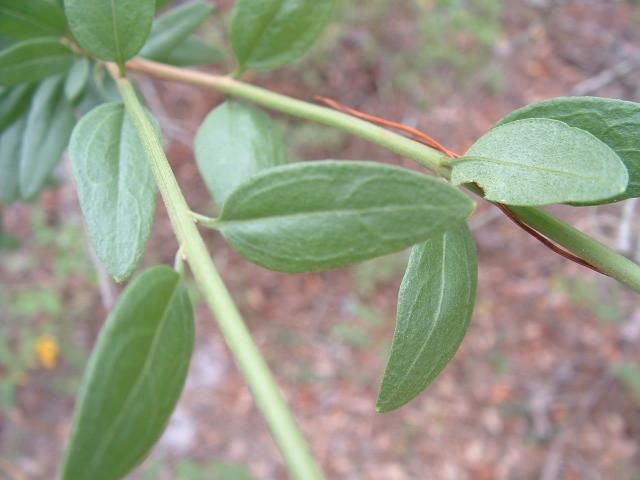
Credit: Lynn Proenza, UF/IFAS
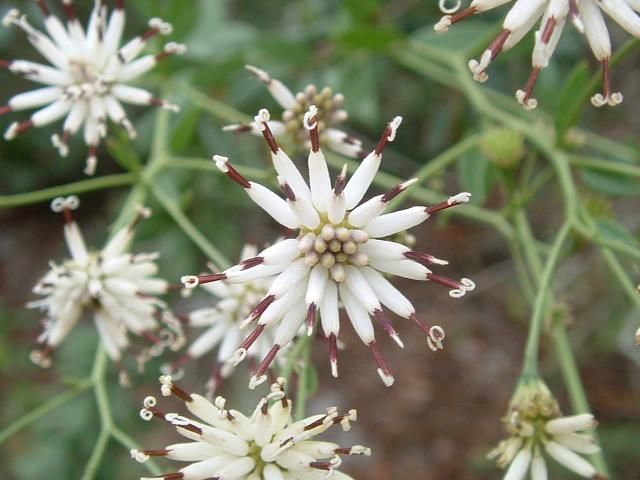
Credit: Lynn Proenza, UF/IFAS
Persea borbonia var. humilis; silk bay
Form
Evergreen, shrub to small tree to 10 m.
Bark
Wood blackish to dark brown. Pubescence on twigs brown to gray with age.
Leaves
Simple, alternate. Elliptic, lanceolate, commonly narrow, 3–10 cm long, 1–3 cm wide. Upper surface glabrous, shiny green. Lower surface with dense brown pubescence that feels smooth and silky turning dull gray with age and eventually sloughing (Figure 33). Apex tapered, blunt. Base also tapered, but acutely. Leaves aromatic.
Flowers
Spring to summer. Silky smooth pubescence.
Fruit
Drupe, 1–1.5 cm diameter.
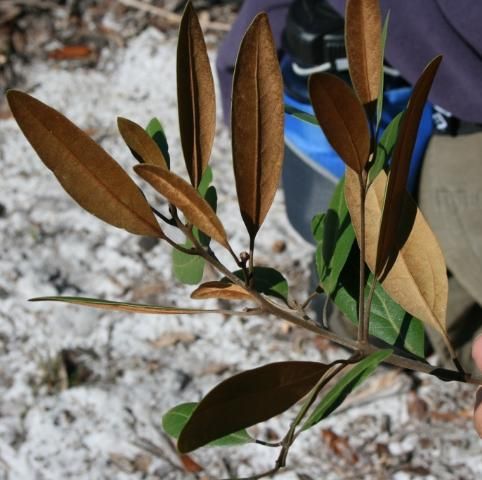
Credit: Michael Andreu, UF/IFAS
Vaccinium myrsinites; shiny blueberry
Form
Small shrub to 60 cm tall. Forms thickets by spreading via subterranean runners.
Bark
Pubescent to glabrous with age.
Leaves
Simple, alternate, sessile, very small, elliptic, 5–15 mm long, 2–10 mm wide. Upper surface glabrous and shiny green. Lower surface with red glands and sparsely pubescent. Margins with crenate or scalloped gland-tipped, ascending teeth sloughing with age (Figure 34).
Flowers
Pink to white, urceolate, 5–8 mm long.
Fruit
Black to bluish-black shiny berry, 5–8 mm in diameter.
Distinguishing characteristics
Vaccinium darowii is very similar to V. myrsinites; however, the leaf surface on V. darowii is glaucous. Unlike the lower leaf surface, the upper leaf surface will typically lose its glaucous appearance. Both species occur in similar sites and ranges.

Credit: Lynn Proenza, UF/IFAS
Glossary
Achene, a small, dry fruit containing one seed (e.g., sunflower seed)
Acuminate, a long, tapering point at the apex of a leaf
Acute, margins that form an angle less than 90° at the base or apex of a leaf
Angled, not round; three or more flat sides adjoining at angles (e.g., triangular or squared in shape)
Attenuate, gradually tapering to a point at the base or apex of a leaf
Capsule, a dry fruit with more than one carpel
Catkin, a spike-like inflorescence with flowers typically compacted together
Corymb, a flat-topped to slightly convex inflorescence
Costapalmate, a palmate palm-like leaf that forms a “V” (as if somewhat folded) due to an elongated hastula extending from the petiole
Crenate, margins with rounded teeth
Cuneate, tapering of the leaf blade at the base of a leaf
Deltoid, triangular in shape
Dioecious, male and female flowers occurring on separate plants
Drupe, a fleshy fruit covering seed(s) in a stony endocarp (e.g., cherry)
Entire, margins smooth, not notched or lobed
Fascicle, a bundle
Glabrous, without hairs
Glaucous, grayish-blue or whitish waxy substance covering a surface
Globose, spherical
Hastula, additional tissue occurring at the tip of the petiole and extending beyond the base of some palm leaves
Husk, the hard outer covering of a seed
Inequilateral, leaf blades at the base of the leaf are not symmetrical
Inflorescence, a flower cluster or group; part of the plant that flowers
Interlacing fissures, bark with fissures that are diamond-shaped (like a chain-link fence)
Impressed, pressed downwards; depressions
Keeled, with protruding longitudinal ridges
Lanceolate, in the shape of a lance with the narrow end occurring at the apex of the leaf
Monoecious, male and female flowers occurring on the same plant
Oblanceolate, in the shape of a lance with the narrow end occurring at the base of the leaf
Oblong, the shape of a leaf in which the leaf blades are equally broad from apex to base and is two or more times longer than broad
Obovate, shape of a leaf in which the broadest point occurs at the apex of the leaf
Obtuse, margins that form an angle greater than 90° at the base or apex of a leaf
Odd-pinnately compound, a compound leaf containing an odd number of leaflets
Ovate, the shape of the leaf in which the broadest point occurs towards the base of the leaf
Ovoid, egg shaped
Peduncle, the stalk of an inflorescence
Persistent, does not fall off; remains attached
Petiole, the stem of a leaf that attaches the leaf blade to the twig
Pistil, the female reproductive organ on a flower
Pubescent, with hairs
Punctate, glands (or other material) appearing as dots on a surface
Recurved, curved backwards
Revolute, margins that curl downwards
Rhizomatous, a plant that has underground stems (subterranean runners) in which new shoots are produced at the nodes. Aboveground, a plant may appear to be separate from others adjacent to it; however, these plants may actually belong to a single specimen
Scurfy, with small scales giving a surface a rough feel and/or crusty appearance
Semi-evergreen, partly evergreen; keeps some foliage year-round
Serotinous, opens via solar heat or fire
Serrate, margins with appressed, serrated (saw-like) teeth
Sessile, leaf attaches directly to a twig, without a petiole
Stellate, star-shaped
Subterranean runners/stems, stems occurring below the surface of the ground
Tardily deciduous, leaves falling off of a plant while new leaves are emerging, usually after wintertime
Terminal leaflet, the leaflet occurring at the tip or end of an odd-pinnately compound leaf
Unarmed, without prickles, thorns, or spines
Urceolate, urn-shaped
Whorled, arrangement of leaves on a twig in which three or more leaves occurring at the same point encircle a twig
References and Further Reading
Abrahamson, Warren G. 2007. Leaf Traits and Leaf Life Spans of Two Xeric-Adapted Palmettos. American Journal of Botany 94(8): 1297–1308. https://doi.org/10.3732/ajb.94.8.1297
Burns, Russell M., and Barbara H. Honkala, tech. coords. 1990. Silvics of North America: 1. Conifers; 2. Hardwoods. Agriculture Handbook 654. U.S. Department of Agriculture, Forest Service, Washington, DC. Available online at https://www.srs.fs.usda.gov/pubs/misc/ag_654/table_of_contents.htm. Accessed October 8, 2024.
Carey, Jennifer H. 1992. Pinus clausa. In: Fire Effects Information System. U.S. Department of Agriculture, Forest Service, Rocky Mountain Research Station, Fire Sciences Laboratory (Producer).
eFloras. 2008. Published on the Internet http://www.efloras.org [accessed July 11, 2011 – August 22, 2011]. Missouri Botanical Garden, St. Louis, MO & Harvard University Herbaria, Cambridge, MA.
Florida Land Steward Program, n.d., “Scrub and High Pine” Available online: https://programs.ifas.ufl.edu/florida-land-steward/forest-resources/upland-forest-ecosystems/scrub-and-high-pine/. Accessed October 8, 2024.
Florida Natural Areas Inventory (FNAI). 2010. “Xeric Hammocks” in: Guide to the natural communities of Florida: 2010 edition. Florida Natural Areas Inventory, Tallahassee, FL. Available online: https://www.fnai.org/PDFs/NC/Xeric_Hammock_Final_2010.pdf. Accessed October 8, 2024.
Godfrey, Robert K. 1988. Trees, Shrubs, and Woody Vines of Northern Florida and Adjacent Georgia and Alabama. Athens, Georgia: University of Georgia Press.
Hall, David W. 1993. Illustrated Plants of Florida and the Coastal Plain. Maupin House, Gainesville, Florida.
Lance, Ron. 2004. Woody Plants of the Southeastern United States: A Winter Guide. Athens, Georgia: University of Georgia Press.
Menges, E. S. 1999. Ecology and conservation of Florida scrub. Pp. 7–22 In: Anderson, R. C., J. S. Fralish, and J. M. Baskin (eds), Savannas, barrens, and rock outcrop plant communities of North America. Cambridge University Press, UK. https://doi.org/10.1017/CBO9780511574627.002
Menges, E. S. 2007. Integrating demography and fire management: an example from Florida scrub. Australian Journal of Botany. 55: 261–72. https://doi.org/10.1071/BT06020
Myers, R. L. 1990. Scrub and High Pine. Pp. 150–193. In: Myers, R.L. and J.J. Ewel (eds.), Ecosystems of Florida. University of Central Florida Press, Orlando, Fl.
Nelson, Gil. 1996. The shrubs and woody vines of Florida. Sarasota, Florida: Pineapple Press Inc.
Radford, Albert E., Harry E. Ahles, and C. Ritchie Bell. 1968. Manual of the vascular flora of the Carolinas. Chapel Hill, North Carolina: University of North Carolina Press.
Scmaltzer, P. A. (1998) Scrub Habitat. Available online: https://www.nbbd.com/godo/ef/scrub/index.html#Scrub%20Communities. Accessed October 8, 2024.
Stein, J., D. Binion, and R. Acciavatti. 2003. Field Guide to Native Oak Species of Eastern North America. [Morgantown, WV]: U.S. Dept. of Agriculture, Forest Service, Forest Health Technology Enterprise Team.
Wunderlin, R. P., and B. F. Hansen. 2003. Guide to the Vascular Plants of Florida, Second Edition. Gainesville, Florida: University Press of Florida.
Wunderlin, R. P., and B. F. Hansen. 2008. Atlas of Florida Vascular Plants. S. M. Landry and K. N. Campbell (application development), Florida Center for Community Design and Research. Institute for Systematic Botany, University of South Florida, Tampa. Available online at https://plantatlas.org
USDA, NRCS. 2011. The PLANTS Database National Plant Data Team, Greensboro, NC 27401-4901 USA. Accessed July 11, 2011–August 22, 2011. Available online at https://plants.usda.gov. Accessed October 8, 2024.